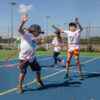by Charlie Nash
YogaFrogs
Yoga offers so many wonderful benefits for the mind, body and soul which can help so many aspects of our daily lives. Sleep is a key part of our health and well-being, as it allows our body to rest and restore. Incorporating a short bedtime yoga sequence into your child’s bedtime routine can calm the mind and relieve tension in the body which can help to induce better sleep.
Gently guide your child through this easy to follow mini routine, you don’t even need a yoga mat and can easily practice this on the bed before settling down for sleep.
Make sure the room is cool to encourage a restorative sleep, turn off the TV, computers and phones, dim the lights or use a bedside lamp to give the room a soft light and as a visual cue to the brain to start winding down, ready for sleep.
1. Easy pose
 To begin, sit in easy pose, to promote inner calm. Imagine a balloon gently pulling your head up to sit a little taller, take in three deep breaths, counting to three on each breath in and three on each breath out. For the first few times you practice this with your child count aloud; that way they can then fully concentrate on their breathing. Focusing on the breath will help the mind begin to unwind and relax.
To begin, sit in easy pose, to promote inner calm. Imagine a balloon gently pulling your head up to sit a little taller, take in three deep breaths, counting to three on each breath in and three on each breath out. For the first few times you practice this with your child count aloud; that way they can then fully concentrate on their breathing. Focusing on the breath will help the mind begin to unwind and relax.
2. Cat/cow pose
 Start on all fours, hands under shoulders, knees under hips. Cow – inhale and gently drop the belly towards the floor, lift the head and tailbone up towards the ceiling.
Start on all fours, hands under shoulders, knees under hips. Cow – inhale and gently drop the belly towards the floor, lift the head and tailbone up towards the ceiling.
 Cat – reverse the movement, exhaling deeply and round the spine, tucking the chin in towards the chest. If your child feels happy to do so, ask them to close their eyes as they do this.
Cat – reverse the movement, exhaling deeply and round the spine, tucking the chin in towards the chest. If your child feels happy to do so, ask them to close their eyes as they do this.
3. Butterfly pose
 Sit with your feet and heels touching. You can introduce some very gentle movement with the breath by lifting the knees up and down. You can, if you feel it is right for your child, encourage them to close their eyes and imagine they are a beautiful butterfly fluttering round their favourite park or place in nature.
Sit with your feet and heels touching. You can introduce some very gentle movement with the breath by lifting the knees up and down. You can, if you feel it is right for your child, encourage them to close their eyes and imagine they are a beautiful butterfly fluttering round their favourite park or place in nature.
4. Lazy forward bend
 This is extremely self-soothing and helps to promote digestion, relieves stress and helps to calm the mind.
This is extremely self-soothing and helps to promote digestion, relieves stress and helps to calm the mind.
Feet should be together and knees bent. The idea isn’t to reach the toes but just to allow the arms to rest where they are comfortable. It’s also nice particularly for bedtime to place some pillows on top of the legs and allow the head to nuzzle into the pillows. Let go of counting the breath and allow your child to fully relax.
They can imagine they are on a boat traveling down a lazy river.
5. Knees to chest
 This is another self-soothing posture. It increases circulation to the head and releases tension in the neck and back. Allow for the knees to come to the chest and clasp arms around the shin area of the leg. Gently rock side to side which gives a gentle bedtime massage to the spine.
This is another self-soothing posture. It increases circulation to the head and releases tension in the neck and back. Allow for the knees to come to the chest and clasp arms around the shin area of the leg. Gently rock side to side which gives a gentle bedtime massage to the spine.
6. Shavasana
Our resting pose, lay in a comfortable position with a favourite toy to cuddle and begin to relax the whole body. Guide your child through
relaxation by naming each body part, for example “Relax your feet, relax your legs” and so on. You could play some sounds from nature, soothing music or use this time as an opportunity to read a short bedtime story.
If your child is still a little restless you can try making a simple lavender and chamomile pillow sack, two tablespoons of dried lavender and one tablespoon of dried chamomile in a little fabric sack tucked under the pillow will provide a soothing scent to send them off to dreamland.
Sweet dreams.
YogaFrogs – bringing weekly yoga, mindfulness, meditation and creativity to children, teens and families across East and West Sussex, www.yogafrogs.co.uk










